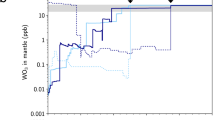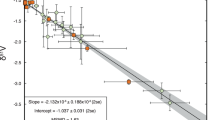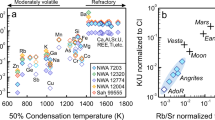Abstract
The Earth–Moon system has unique chemical and isotopic signatures compared with other planetary bodies1,2,3; any successful model for the origin of this system therefore has to satisfy these chemical and isotopic constraints. The Moon is substantially depleted in volatile elements such as potassium compared with the Earth and the bulk solar composition4, and it has long been thought to be the result of a catastrophic Moon-forming giant impact event5. Volatile-element-depleted bodies such as the Moon were expected to be enriched in heavy potassium isotopes during the loss of volatiles; however such enrichment was never found6. Here we report new high-precision potassium isotope data for the Earth, the Moon and chondritic meteorites. We found that the lunar rocks are significantly (>2σ) enriched in the heavy isotopes of potassium compared to the Earth and chondrites (by around 0.4 parts per thousand). The enrichment of the heavy isotope of potassium in lunar rocks compared with those of the Earth and chondrites can be best explained as the result of the incomplete condensation of a bulk silicate Earth vapour at an ambient pressure that is higher than 10 bar. We used these coupled constraints of the chemical loss and isotopic fractionation of K to compare two recent dynamic models that were used to explain the identical non-mass-dependent isotope composition of the Earth and the Moon. Our K isotope result is inconsistent with the low-energy disk equilibration model7, but supports the high-energy, high-angular-momentum giant impact model8 for the origin of the Moon. High-precision potassium isotope data can also be used as a ‘palaeo-barometer’ to reveal the physical conditions during the Moon-forming event.
This is a preview of subscription content, access via your institution
Access options
Subscribe to this journal
Receive 51 print issues and online access
$199.00 per year
only $3.90 per issue
Buy this article
- Purchase on Springer Link
- Instant access to full article PDF
Prices may be subject to local taxes which are calculated during checkout



Similar content being viewed by others
References
Ringwood, A. E. Origin of the Earth and Moon (Springer, 1979)
Wiechert, U. et al. Oxygen isotopes and the moon-forming giant impact. Science 294, 345–348 (2001)
Zhang, J., Dauphas, N., Davis, A. M., Leya, I. & Fedkin, A. The proto-Earth as a significant source of lunar material. Nat. Geosci. 5, 251–255 (2012)
Taylor, S. R. Lunar and terrestrial crusts: a contrast in origin and evolution. Phys. Earth Planet. Inter. 29, 233–241 (1982)
Canup, R. M. Simulations of a late lunar-forming impact. Icarus 168, 433–456 (2004)
Humayun, M. & Clayton, R. N. Potassium isotope cosmochemistry: genetic-implications of volatile element depletion. Geochim. Cosmochim. Acta 59, 2131–2148 (1995)
Pahlevan, K. & Stevenson, D. J. Equilibration in the aftermath of the lunar-forming giant impact. Earth Planet. Sci. Lett. 262, 438–449 (2007)
Lock, S. J. et al. A new model for lunar origin: equilibration with Earth beyond the hot spin stability limit. In Proc. 47th Lunar Planet. Sci. Conf. (Lunar and Planetary Science Institute, 2016)
Wasserburg, G. J., Macdonald, G. J., Hoyle, F. & Fowler, W. A. Relative contributions of uranium, thorium, and potassium to heat production in the Earth. Science 143, 465–467 (1964)
Anders, E. & Grevesse, N. Abundances of the elements: meteoritic and solar. Geochim. Cosmochim. Acta 53, 197–214 (1989)
Arevalo, R., McDonough, W. F. & Luong, M. The K/U ratio of the silicate Earth: insights into mantle composition, structure and thermal evolution. Earth Planet. Sci. Lett. 278, 361–369 (2009)
Halliday, A. N. & Porcelli, D. In search of lost planets – the paleocosmochemistry of the inner solar system. Earth Planet. Sci. Lett. 192, 545–559 (2001)
Sharp, Z. D., Shearer, C. K., McKeegan, K. D., Barnes, J. D. & Wang, Y. Q. The chlorine isotope composition of the Moon and implications for an anhydrous mantle. Science 329, 1050–1053 (2010)
Paniello, R. C., Day, J. M. D. & Moynier, F. Zinc isotopic evidence for the origin of the Moon. Nature 490, 376–379 (2012)
Kato, C., Moynier, F., Valdes, M. C., Dhaliwal, J. K. & Day, J. M. D. Extensive volatile loss during formation and differentiation of the Moon. Nat. Commun. 6, 7617 (2015)
Wang, K. & Jacobsen, S. B. An estimate of the bulk silicate earth potassium isotopic composition based on MC-ICPMS measurements of basalts. Geochim. Cosmochim. Acta 178, 223–232 (2016)
Barnes, I. L. et al. Isotopic abundance ratios and concentrations of selected elements in some Apollo 15 and Apollo 16 samples. Proc. Lunar Planet. Sci. Conf. 4, 1197–1207 (1973)
Garner, E. L., Machlan, L. A. & Barnes, I. L. The isotopic composition of lithium, potassium, and rubidium in some Apollo 11, 12, 14, 15, and 16 samples. In Proc. Sixth Lunar Sci. Conf. 1845–1855 (Lunar and Planetary Science Institute, 1975)
Church, S. E., Tilton, G. R. & Wright, J. E. Volatile Element depletion and 39K/41K fractionation in lunar soils. Abstr. Lunar Planet. Sci. Conf. 7, 146–148 (1976)
Li, W., Beard, B. & Li, S. Precise measurement of stable potassium isotope ratios using a single focusing collision cell multi-collector ICP-MS. J. Anal. At. Spectrom. 31, 1023–1029 (2016)
Schauble, E. A. Applying stable isotope fractionation theory to new systems. Rev. Mineral. Geochem. 55, 65–111 (2004)
Yu, Y., Hewins, R. H. & Alexander, C. M. O.’D. & Wang, J. Experimental study of evaporation and isotopic mass fractionation of potassium in silicate melts. Geochim. Cosmochim. Acta 67, 773–786 (2003)
Richter, F. M., Mendybaev, R. A., Christensen, J. N., Ebel, D. & Gaffney, A. Laboratory experiments bearing on the origin and evolution of olivine-rich chondrules. Meteorit. Planet. Sci. 46, 1152–1178 (2011)
Young, E. D. Assessing the implications of K isotope cosmochemistry for evaporation in the preplanetary solar nebula. Earth Planet. Sci. Lett. 183, 321–333 (2000)
Clayton, R. N. Oxygen isotopes in meteorites. Annu. Rev. Earth Planet. Sci. 21, 115–149 (1993)
Young, E. D. et al. Oxygen isotopic evidence for vigorous mixing during the Moon-forming giant impact. Science 351, 493–496 (2016)
Melosh, H. J. New approaches to the Moon’s isotopic crisis. Phil. Trans. R. Soc. A 372, 20130168 (2014)
Zindler, A. & Jacobsen, S. B. Rethinking lunar formation: back to the future? In Proc. 41st Lunar Planet. Sci. Conf. Abstract No. 2702 (Lunar and Planetary Institute, 2010)
Pahlevan, K., Stevenson, D. J. & Eiler, J. M. Chemical fractionation in the silicate vapor atmosphere of the Earth. Earth Planet. Sci. Lett. 301, 433–443 (2011)
Canup, R. M., Visscher, C., Salmon, J. & Fegley, B., Jr. Lunar volatile depletion due to incomplete accretion within an impact-generated disk. Nat. Geosci. 8, 918–921 (2015)
Langmuir, C. H., Bender, J. F. & Batiza, R. Petrological and tectonic segmentation of the East Pacific Rise, 5°30′–14°30′ N. Nature 322, 422–429 (1986)
Jacobsen, S. B. & Wasserburg, G. J. Nd and Sr Isotopic Study of the Permian Oslo Rift. Report No. 78-701, 194–196 (US Geological Survey, 1978)
Jacobsen, S. B. & Dymek, R. F. Nd and Sr isotope systematics of clastic metasediments from Isua, West Greenland: identification of pre-3.8 Ga differentiated crustal components. J. Geophys. Res. 93, 338–354 (1988)
Strelow, E. W. E. & Von, S. Toerien, F. & Weinert, C. H. S. W. Accurate determination of traces of sodium and potassium in rocks by ion exchange followed by atomic absorption spectroscopy. Anal. Chim. Acta 50, 399–405 (1970)
Humayun, M. & Clayton, R. N. Precise determination of the isotopic composition of potassium: application to terrestrial rocks and lunar soils. Geochim. Cosmochim. Acta 59, 2115–2130 (1995)
Acknowledgements
This work was funded by the NASA Emerging Worlds program (NNX15AH66G). K.W. acknowledges financial support from the Harvard Origins of Life Initiative Postdoctoral Fellowship during his time at Harvard. We thank NASA JSC and CAPTEM for providing lunar samples and M. Petaev, S. Stewart, S. Lock and B. Jolliff for discussions.
Author information
Authors and Affiliations
Contributions
S.B.J. and K.W. ( ) designed the study. K.W. performed the analysis. K.W. and S.B.J. wrote the manuscript.
) designed the study. K.W. performed the analysis. K.W. and S.B.J. wrote the manuscript.
Corresponding author
Additional information
Reviewer Information Nature thanks A. Treiman and E. Young for their contribution to the peer review of this work.
Extended data figures and tables
Extended Data Figure 1 The estimation of the pressure effect on α.
The experiments on K isotope fractionation during evaporation and condensation are very limited. One study22 conducted evaporation experiments on chondritic analogue materials in a high vacuum (around 10−9 atm) and at various higher pressures (1 × 10−5, 9 × 10−5, 7.2 × 10−5, 1.8 × 10−5, 1.8 × 10−4, 1.4 × 10−3, 1.3 × 10−2 and 1 atm). One of their major observations is that the degree of K isotope fractionation during evaporation decreases with higher pressures. Another study23 indicates that not only the pressure but also the composition (that is, H2, He, CO2) of the surrounding gas would affect the degree of K isotope fractionation. Here the red dots show the calculated effective Rayleigh fractionation factors based on the experimental data22,23 versus pressures. The effective Rayleigh fractionation factor is correlated with pressures and the observed value from this study suggests a >10 bar pressure during the loss of K from the Moon. Note that because not all the experiments are conducted at the same surrounding gas environment and the composition of the surrounding gas would also affect the effective fractionation factor (downward arrows in the figure), the correlation between the effective fractionation factor and pressure is not perfect. This >10 bar pressure from this study is at best a first-order estimation.
Extended Data Figure 2
An artist’s rendering of the two recent models of the origin of the Moon and their implications for K isotopes. Scenario 1 is from ref. 7; scenario 2 is from ref. 8.
Source data
Rights and permissions
About this article
Cite this article
Wang, K., Jacobsen, S. Potassium isotopic evidence for a high-energy giant impact origin of the Moon. Nature 538, 487–490 (2016). https://doi.org/10.1038/nature19341
Received:
Accepted:
Published:
Issue Date:
DOI: https://doi.org/10.1038/nature19341
This article is cited by
-
Rapid transition from primary to secondary crust building on the Moon explained by mantle overturn
Nature Communications (2023)
-
Potassium isotope heterogeneity in the early Solar System controlled by extensive evaporation and partial recondensation
Nature Communications (2022)
-
Nd isotope variation between the Earth–Moon system and enstatite chondrites
Nature (2022)
-
Stochastic accretion of the Earth
Nature Astronomy (2022)
-
Lunar compositional asymmetry explained by mantle overturn following the South Pole–Aitken impact
Nature Geoscience (2022)
Comments
By submitting a comment you agree to abide by our Terms and Community Guidelines. If you find something abusive or that does not comply with our terms or guidelines please flag it as inappropriate.



